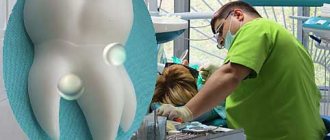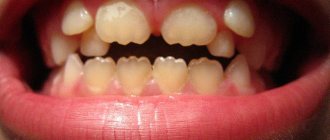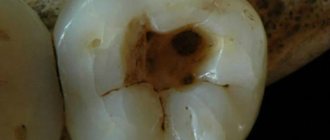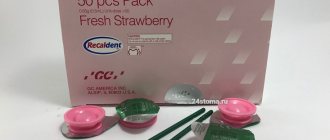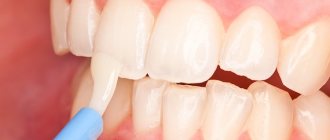Where does the abscess come from and what is its danger?
In the vast majority of cases, an abscess on the gum is associated with a tooth, often with a milk tooth. The most amazing thing is that the tooth may appear healthy from the outside, it may have a beautiful filling, and the tooth may not hurt. Why does pus still appear?
Baby teeth are less resistant to infection than permanent teeth; they are designed for a short service life, although they, like permanent teeth, have a nerve and roots. However, the roots of baby teeth begin to dissolve after five years. Caries in such teeth spreads much faster. Within three months, a cavity can form in the tooth, reaching the nerve. If caries is not treated, all pathogenic bacteria enter the dental nerve, and then, through the nerve, the microbes enter the bone. Bone is quite comfortable for microbes. They multiply there, dissolve the bone, which is accompanied by the formation of pus. If the tooth is open, there is a hole in it, pus comes out into the oral cavity. If food particles, fragments of destroyed enamel get into the tooth, or the tooth is covered with a filling without adequate treatment, pus can no longer flow freely. If the pus cannot flow out through the tooth cavity, it begins to look for another way out. The pus melts the bone and comes out under the gum. The outer covering of the gum, under which the pus has come out, swells and takes the form of a lump. Over time, the lump may burst and pus leaks out.
Once the pus is released, the lump may disappear and the gums may heal until the pus collects in large quantities again. The danger of such “bumps” is as follows:
- there is always an infection in the body (you should never forget that the abscess is not just on the gum, but in the head);
- the pus that is in the jaw dissolves the bone and can damage the growing permanent tooth.
The disappearance of an abscess next to a tooth never means recovery.
Symptoms that appear along with an abscess
- redness on the gum;
- tooth pain (optional);
- There is a hole in the tooth or there may be a filling on it;
- enlarged lymph nodes (dense “balls” appear under the lower jaw).
Sometimes a lump is discovered by chance, and the child may not be bothered by anything at all. The parent should periodically examine the child's mouth independently.
Purulent lump
The main reasons for the development of pustules on the gums:
- The most important factor that leads to the formation of a purulent lump or gumboil is periodontitis, which develops as a result of untreated caries. In this case, the size of the carious defect does not matter, and even the smallest lesion can cause a strong inflammatory reaction.
- Also, the cause of the formation of an abscess over a tooth can be an injury received from a fall or blow.
- Sometimes flux is a consequence of tissue damage from sharp objects (for example, if a child has the habit of chewing a pencil or toothpick).
Manifestations
The symptoms of this pathology are quite specific. At the initial stages of development of the purulent process, the child complains of pain and a feeling of fullness in the tooth area. At this time, a red swelling appears on the gum in the projection of the tooth root, which gradually increases in size, and pus accumulates in its center. This lump is soft to the touch and hurts when you press on it. As inflammation progresses, the formation becomes whitish and a white abscess forms.
At the same time, the general condition of the baby may suffer. Children become restless, refuse to eat, and their temperature rises.
If full treatment is not carried out at this stage, then as pus accumulates, the pressure inside the abscess increases and spontaneous opening of the white lump occurs. In this case, a fistula is formed, which connects the surface of the gums with the pathological focus. After the lump bursts, the child experiences relief of symptoms: pain decreases.
As the inflammatory process subsides, the fistulas can close on their own, but this does not mean that recovery has occurred, since the pathological focus itself remains unsanitized. With a decrease in the protective properties of the body, the disease can be activated with the reappearance of an abscess and fistulas.
Treatment
If a purulent lump is detected in the child’s mouth, it is necessary to contact the dentist as early as possible.
If the cause of the formation of an abscess or fistula is a baby tooth, then treatment will be reduced to its urgent removal. It is impossible to leave such a tooth, since the preservation of even a slight focus of inflammation can lead to the death of the permanent tooth germ.
If flux has formed over a molar, then all therapeutic measures will be aimed at preserving it. In this case, the dentist will open the lump, clean the cavity from purulent masses and treat it with an antiseptic. Removing a permanent tooth is a last resort and is carried out only when there is significant destruction.
Complications
Despite the fact that purulent bumps are rarely large, their complications can be extremely serious and dangerous.
- The death of the rudiments of permanent teeth leads to edentia. Such a condition in childhood can cause improper development of the maxillofacial apparatus and bite pathology, which will require serious orthodontic treatment in the future.
- Chronic purulent lesions and fistulas in the oral cavity are a source of infection, which can spread and cause inflammation in other organs: tonsils or adenoids.
- The constant inflammatory process changes the activity of the immune system, which becomes more sensitive to the effects of various allergens. In this case, the child may develop hypersensitivity reactions even to those substances to which allergies were not previously observed.
- If the abscess does not open outward, then the pus can spread deep into the tissues with the formation of phlegmon - a severe complication that is life-threatening.
Memo to parents
If you find a purulent lump in your child, then you need to remember several important nuances:
- It is strictly forbidden to try to open an abscess on your own. This can lead to pus entering the bloodstream and the development of sepsis - blood poisoning.
- You cannot carry out any warming procedures: apply compresses or rinse your mouth with hot liquid. This will only worsen the inflammation.
- Cold can be applied externally to the cheek in the area of the lump; this will somewhat alleviate the symptoms and slow down the development of the abscess.
- At the first symptoms of gumboil, you should contact your pediatric dentist for professional treatment.
Never do
You should never heat your gum or cheek, no warm compresses or salt or other “folk remedies”! It’s better not to do anything at all before going to the doctor. After warm compresses, pus may spread not only in the jaw, but also in the cheeks, throat, and neck. Situations arise that are dangerous not only to health, but also to life.
Contraindicated
- refusal to brush teeth;
- independent opening of the abscess;
- taking medications without the consent of a doctor (except for painkillers).
Causes of gum fistula in a child
In most cases, the occurrence of a fistula is provoked due to the fact that pathogenic microflora is created in the child’s oral cavity. The active development of pathogenic microorganisms leads to the fact that suppuration begins to gradually accumulate in the gingival tissues.
Dentists especially emphasize that fistula should not be perceived as an independent disease. Often this is just a symptom showing that there are serious problems with the child’s health, and an inflammatory process is developing in the body. And where there is inflammation, there are sources.
There are several reasons that can contribute to suppuration:
- Periodontitis. It often causes problems in young children when parents do not pay attention to caries of baby teeth. Often it is due to severe tooth decay that the inflammatory process begins. If baby teeth have already been replaced by molars, the source of inflammation will be located right next to the root. In this place suppuration begins to form. It gradually breaks through, and a fistula canal is formed with all the attendant dangers.
- Cyst. Often a fistula occurs at the site of a dental cyst. This is the name for a formation on a child’s gum, inside of which fluid begins to accumulate. Then everything happens according to the same mechanism as in the case of periodontitis. Once there is too much liquid, it begins to break out.
- Osteomyelitis. Another common source of inflammation. It concentrates in the gum area. If you do not start treatment on time, you may experience bone tissue decomposition. A focus of infection is created, the inflammatory process is constantly progressing. The appearance of a fistula is inevitable, because at some point there is too much pus and the tissues cannot hold it.
- Gum injury. The reasons may be different - too hard a toothbrush, improper oral hygiene, scratches, gum punctures when eating food. Such a small wound becomes a source of infection in the body.
Determining the causes of inflammation and suppuration becomes the main task of the dentist. It is important to understand what exactly caused the fistula. Our dentists use advanced diagnostic methods to identify the source of the problem as quickly as possible and eliminate it using one of the available methods.
Treatment
Depending on whether a permanent or baby tooth caused a lump on the child’s gum , the doctor carries out appropriate treatment. If a permanent tooth is damaged, seek help immediately while there is a chance to save the child’s tooth. The doctor will have to remove the nerve and fill the canals. In this case, adult dental treatment is a necessity, because if high-quality treatment and appropriate treatment are not carried out, the child may lose a tooth.
Milk teeth are removed immediately - their root system has not yet had time to form, and it is impossible to properly fill the canals. In addition, if a diseased tooth is left, the molar may grow back with defects (stains, damage.
At the Family Dentistry Center, you can remove a child’s tooth without pain or fear. All procedures in the clinic are performed under medical sedation. While the baby is sleeping peacefully and does not feel pain or discomfort, the doctor can carry out all the necessary procedures. Being able to treat your teeth while you sleep is a great way to cope with dental phobia.
Manifestation of hyperplasia
- The color of the enamel changes. Yellow spots appear on it. Discoloration of the enamel may be accompanied by pain, but the tooth still retains its integrity.
- Underdevelopment of enamel, which manifests itself in the form of wavy enamel and furrowed depressions.
- Complete absence of enamel.
The most severe disease is the complete absence of the top layer of enamel, which can manifest itself as: tooth deformation, pain due to temperature changes, pain due to mechanical impact on the teeth.
Risk factors for the development of hyperplasia on permanent teeth:
- Disease of rickets or various infectious diseases.
- Excess of vitamins A, C, D in the body.
- Syphilis disease.
Prevention
There are no special unique ways to prevent dental disease in children. Ulcers on the gums are the result of untreated caries. Therefore, all preventive measures are aimed at preventing caries:
- oral hygiene (make sure your baby brushes his teeth properly);
- balanced diet;
- rinsing your mouth every meal;
- preventive procedures (remineralization, fluoridation; fissure sealing);
- timely dental treatment;
- preventive examinations at the dentist 2 times a year (some experts recommend once every 3 months if the baby already has treated teeth).
Timely dental treatment for children and proper hygiene will help avoid many dental problems. Teach your child to take care of the health of their teeth and beautiful children's smiles will delight you every day!
Treatment of hyperplasia
Therapeutic treatment, in which grinding of enamel drops and filling of pinpoint manifestations of the disease are prescribed. In children, treatment of hyperplasia is carried out using a restorative method.
To restore teeth, photopolymers are used, which completely restore the structure and color of the enamel.
Veneers are installed or artificial crowns are made. Of all types of hyperplasia, only pearl drops on the neck of the tooth can be cured, which over time can cause inflammation of the gums. During the treatment process, excess enamel is removed from the tooth using diamond grinding, and a course of phosphorus-containing medications is prescribed.
The main symptoms of gum fistula in children
It is very important to understand that a child is at risk of developing a fistula at a very early stage. But often parents in precisely this situation cannot find any signs of a problem. Inflammation can indeed form without serious external manifestations.
But as the disease progresses, the symptoms become more and more severe. First of all, a small swelling appears at the site of inflammation. Over time, it begins to become more and more pronounced, turns red, and the tissues can warm up from the inside.
Symptoms change with development. Among the important indications:
- It's a dull pain. Usually it turns out to be quite strong, the child begins to complain and be capricious. It may pass for a while and this will lull your vigilance. But there is a serious risk that the sensations will soon return and be even more noticeable.
- Swelling on the gum. It may look like a small abscess, similar to those that sometimes appear on human skin.
- Cone development. Usually it is quite large in size and has a whitish tint. In the inflamed area, the pain intensifies and other unpleasant sensations appear.
- Tooth mobility. It becomes more noticeable as the disease spreads. The tooth becomes very loose, and in the later stages it can even come out of the gums.
- Discharge from the inflamed area. When you press on the gum, it begins to ooze pus and blood.
Also, in the later stages of inflammation, a strong bad breath appears, and other unpleasant symptoms may develop.
It is often possible to find a fistula even on your own during an external examination. Moreover, without a properly selected treatment program, inflammation can spread deeper into the tissue and gradually worsen.
How to treat a fistula at home
We emphasize that home treatment is only one of the auxiliary methods prescribed by a doctor.
At home, you will need to treat the oral cavity using special decoctions with a pronounced calming and antiseptic effect. You can use decoctions of calendula and chamomile, solutions of salt and soda.
Also allowed are lotions made from aloe and Kalanchoe, and the application of special ointments prepared at home. They are made using crushed chamomile herbs mixed with sea buckthorn oil.
This home treatment can significantly speed up the recovery period and reduce your child’s discomfort.
The main risks of gum fistula and the risk of complications
Without proper timely treatment, fistulas often cause complications. They can affect not only the oral cavity, but also the internal organs of the baby.
There are several common risks:
- Severe intoxication of the body. Occurs because pus is constantly secreted from the wound. The pathogenic microflora that develops poses a great danger.
- Tooth loss. Sometimes it is necessary to remove only the one whose root has been affected. But cases with gradual spread of inflammation are also common, when several teeth need to be removed.
- Damage to the periosteum. It has far-reaching consequences associated with inflammation of tissues and bones, and the need for surgical intervention.
- Sinusitis. The infection quickly spreads to the human maxillary sinuses and begins to rapidly progress, covering ever larger areas.
Other dangerous potential complications include the need for perforation of the cheek, flux, removal of tonsils, and gastrointestinal disorders.
As with any other type of inflammation, the hours begin to count. Therefore, if a problem occurs, you need to seek dental help as quickly as possible.
